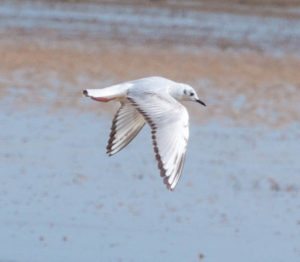We started our walk at Boulder Reservoir with excellent sunny weather and low wind, allowing us to see the birds on the lake quite easily without many waves. Boulder Reservoir is the largest reservoir in the county in terms of both size and volume creating an excellent environment for birds but also for recreational boating, fishing, swimming, and jogging. It also provides and holds all water for the Northern Water Distinct for drinking and irrigation. We covered the area in two sections, the first on the southwestern shore of the reservoir which is extremely popular in summer for recreation, and the northern section from the West Reservoir Trailhead.
Immediately after parking we found a large group of American coots feeding in the shallows of the swim beach. Among the flock was a lone female Ruddy duck. Belonging to the genus of “Stiff-tailed ducks”, it is a small freshwater fowl with a large range across North America. Like all in its genus, the Ruddy duck has a stiff tail (often described as looking like a bundle of Popsicle sticks), males have a bright blue bill, and a body that depending on season and sex is rusty to brown in color. These birds are currently in the process of moving to their warmer wintering grounds further south in the Unites States and into Northern Mexico.
Further down the shoreline we found the Rusty blackbirds that have been seen in the area for the last several days, a rarity that drew many local birders to the reservoir. This blackbird is very similar to the Brewer’s blackbird that is common in Colorado but is an uncommon accidental migrant in this part of the west. Unlike the Brewer’s blackbird, it prefers quiet spruce forest and boreal bog and not parks, fields, pastures, lawns, and parking lots. During winter the differences between the sister species becomes most obvious with both the male and female getting buffy and ruddy patterning on their bodies. This was the state the pair we saw were in.
On the north side of the reservoir we got another cool sighting, two Bonaparte’s gulls. This small bird is the smallest gull in North America aside from the elusive Little gull. They have dainty pink feet, a small beak, and off-white coloring. During winter plumage (what we saw) it trades its distinctive black hood for white save for a small black patch over the ear. These gulls are a real treat as they head south for the winter.
Other highlights included a Ferruginous hawk perched in a tree on our way out, a pair of Northern harriers, and all three species of mergansers!
In all, we heard or saw 28 taxa; good for this time of year at the reservoir!
- Cackling Goose 250
- Canada Goose 100
- Gadwall 2
- Mallard 2
- Lesser Scaup 1
- Common Goldeneye 8
- Hooded Merganser 15
- Common Merganser 8
- Red-breasted Merganser 6
- Ruddy Duck 1
- Horned Grebe 1
- Western Grebe 6
- American Coot 80
- Bonaparte’s Gull 2
- Ring-billed Gull 200
- Herring Gull 1
- Great Blue Heron 1
- Northern Harrier 2
- Red-tailed Hawk 3
- Red-tailed Hawk (Harlan’s) 1
- Ferruginous Hawk 1
- Blue Jay 1
- Black-billed Magpie 2
- Black-capped Chickadee 2
- European Starling 100
- House Finch 4
- Red-winged Blackbird 1
- Rusty Blackbird 2
If anyone would like me to share the eBird checklist with them please email me at aidan@coohill.com




Comments
Write Comment